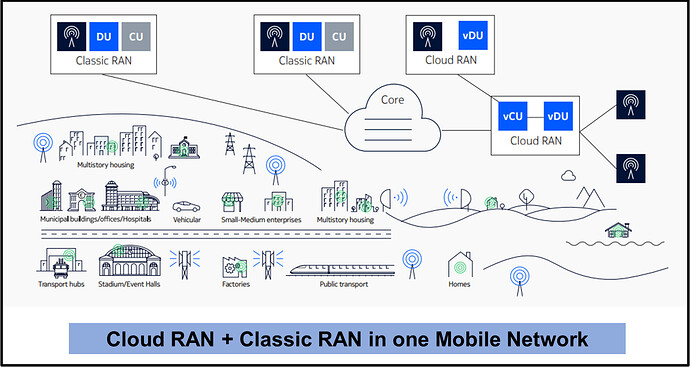-
My friend: Hi Ibrahim, I have a question for you.
- Me: Go ahead, please.
-
My friend: I was wondering what is the difference between 5G Cloud RAN and 5G Classic RAN?
- Me: The difference is in the so-called baseband computing, which is one HW unit contains the CU and DU in Classic RAN, while in Cloud RAN, it is consisting of two separated SW functions called DU and CU implemented over a COTS HW, whereby the RU is the same for Cloud RAN and Classic RAN. Furthermore, the term Cloud RAN is used here to reflect the target state where DU and CU software is fully cloud-native rather than only virtualized (“vRAN”). And let me say that 5G Cloud RAN will introduce a lot of benefits for the mobile networks such as flexibility in deployment models such as distributed or centralized RAN, where pooling of resources between different sites can be done, and scalability of compute resources as HW is separated from SW, and so MNOs have the option to select the cloud infrastructure that fits them best.
-
My friend: So, can the 5G Cloud RAN solution replace the 5G Classic RAN approach?
- Me: Future RAN is expected to evolve gradually towards Cloud RAN based solutions, which will be mainly deployed alongside existing purpose-built Classic RAN networks. However, choosing any solution will depend on the MNO strategy. For example, if the MNO strategy is to go for Cloud-native approach, so Cloud RAN will dominate, and classic RAN may be there for sites with special conditions. While if the MNO strategy is to deploy Cloud RAN where it is most beneficial for them and their customers, while keeping purpose-built as their main choice of architecture, then Classic RAN will dominate.
-
My friend: But why MNO can decide to keep Classic RAN, although Cloud RAN should have more benefits?
- Me: There is no one solution fits all. As, for example, if we have a green-field operator, then Cloud RAN will be an ideal solution for them when building the network from scratch. While for brown-field operators, introducing Cloud RAN, means extra cost for swapping the current classic RAN, and also to build new data centers where centralized RAN can be integrated. Also, the benefits of Cloud RAN which we are discussing should be proved and there are some MNOs who are the early adaptors to the new technologies and willing to test it, so Cloud RAN will be a goal for them to introduce to their network, while other MNOs are skeptical about new technologies and wait to see the results and then follow the good ones, so those MNOs will keep using Classic RAN until the benefits of Cloud RAN is real on the ground.
-
My friend: Thank you very much, you made it very clear.
- Me: You are most welcome.
LinkedIn: ![]()
